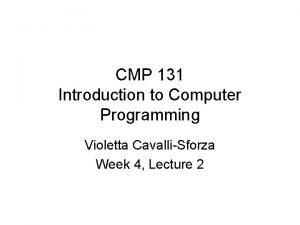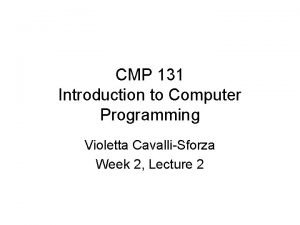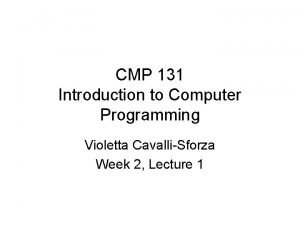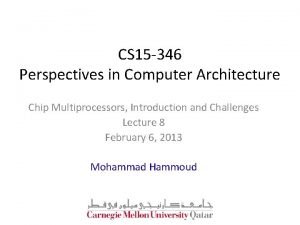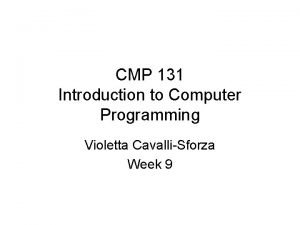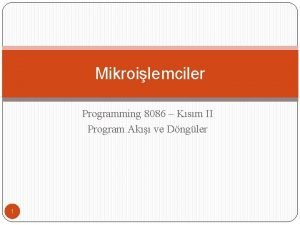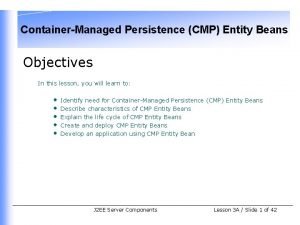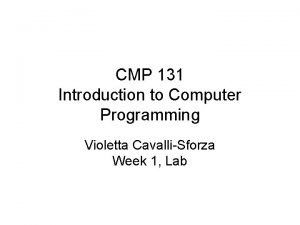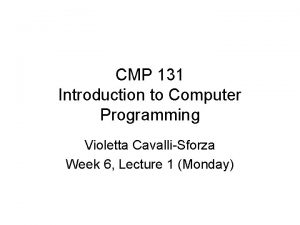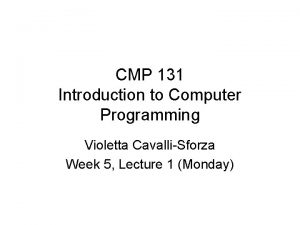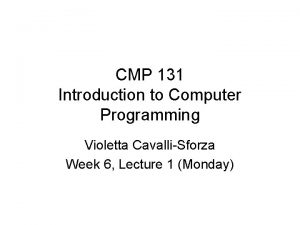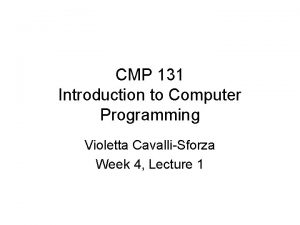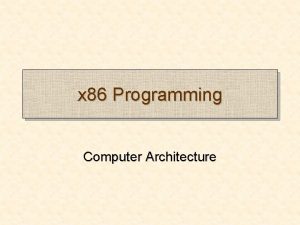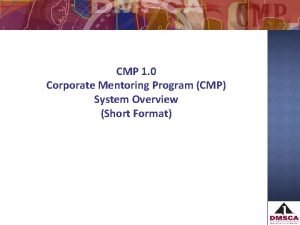CMP 131 Introduction to Computer Programming Violetta CavalliSforza



















- Slides: 19

CMP 131 Introduction to Computer Programming Violetta Cavalli-Sforza Week 3, Lecture 2

Today’s Plan • • Questions Quiz (1/2 hour) Break (brief) Lecture: Important Programming Concepts

Program Structure • Programs are made up of: – Program headers – Declaration statements: • Name things • Allocate memory • Examples: – Constant Definitions – Type Definitions – Variable Declarations – Executable statements • Statements that perform actions

Executable Statements • • Assignment statements Selection statements Looping statements ….

Important Structured Programming Concepts • Selection • Repetition/Looping/Iteration • Sequential execution (stacking) • Nesting • Blocks & Compound Statements (Most high-level PLs provide constructs for these important structured programming concepts. Pascal was one of the first PLs to provide them. )

Selection • Conditional statements – Condition controlled execution – Single branch : IF <condition> THEN – Two branches : IF <condition> THEN <statements> ELSE <statements> – Multiple branches: CASE statement

Selection Examples • Single branch: – IF a condition is true THEN perform an action – The condition is tested once – The action is performed once • Examples: – IF it’s cold THEN wear a coat – IF a homework is due THEN do it –…

Selection Examples • Two branches: – IF a condition is true THEN perform an action ELSE perform a different action – The condition is tested once – One of the two actions is performed once • Examples: – To take the absolute value of a number: IF N >= 0 THEN return N ELSE return -N – IF the time is before noon THEN say good morning ELSE say good afternoon –…

Selection Examples • Multiple branches: – – The condition is tested once Several values of the condition are possible Several actions are possible One of the actions is performed once • Examples: – CASE Score OF 10, 9 : Grade is A 8, 7 : Grade is B 6, 5 : Grade is C OTHERWISE Grade is F –…

Repetition / Looping / Iteration • Fixed / Definite – Know before entering how many times will repeat loop body – While the “how many times” may be a variable: • Its value is set before entry into the loop • Its value may not (should not) be changed inside the loop – FOR loop • Variable Condition / Indefinite – Don’t know before entering how many times will repeat loop body – Entry into / exit from loop is controlled by a variable that can be changed inside the loop – REPEAT…UNTIL : tests condition at end – WHILE … DO : tests condition at start

Mean of 20 Numbers: Refinement PROCESSING: Initialize Sum to 0 Do the following 20 times: Get a Number Add it to Sum Compute Mean as Sum / 20 This is an example of definite looping: You know how many times you go around the loop when you start.

Mean of N Take 1: Refinement PROCESSING: Initialize Sum to 0 Prompt for value of Count Read value of Count Do the following Count times: Prompt for Number Read Number Add Number to Sum Compute Mean as Sum / Count This is ALSO an example of definite looping : You know how many times you go around the loop when you start.

Mean of N Numbers (Take 2): Refinement PROCESSING: Initialize Sum to 0 Initialize Count to 0 repeat Prompt for Number Read Number Add Number to Sum Increment Count by 1 until no more numbers Compute Mean as Sum / Count

Mean of N (Take 3) PROCESSING: Initialize Sum to 0 called a sentinel value because it guards the loop Initialize Count to 0 Prompt for Number Read Number while Number is not equal to -99999 do: Add Number to Sum Increment Count Prompt for Number Read Number Compute Mean as Sum / Count This is also an example of indefinite looping : You DO NOT know how many times you go around the loop until you finish.

Stacking • Two meanings: – sequential execution vs. nested execution • one statement/block of code after the other, vs. • one statement/block of code inside the other – a way of storing and retrieving data: • Last-In First-Out (LIFO) regime • Used in a certain style of processor architecture (stack machines) • Used for memory management at runtime with procedure and function calls. • Used for certain types of applications (e. g. search)

Nesting • A block of code is visually placed inside another block of code AND • The execution of the internal block of code is controlled by the execution of the external block of code. • Ex. Do the following 20 times: Get a Number Add it to Sum

PROGRAM Silly (output); CONST Name = 'George'; Age = 26; VAR J, Sum : integer; BEGIN Sum : = 0; FOR J : = 1 TO 10 DO Sum : = Sum + J; writeln ('My name is ': 28, Name); writeln ('My age is ': 27, Age); writeln ('The sum is ': 28, Sum) END.

PROGRAM Silly (output); CONST Name = 'George'; Age = 26; VAR J, Sum : integer; BEGIN Sum : = 0; FOR J : = 1 TO 10 DO Sum : = Sum + J; writeln ('My name is ': 28, Name); writeln ('My age is ': 27, Age); writeln ('The sum is ': 28, Sum) END.

Blocks of Code • Most statements like FOR, IF, etc. . control only one other statement: – What do I mean by that? • To make them control multiple statements, you need to enclose those statements in a bracketing mechanism: BEGIN … END. • BEGIN … END – essentially says: treat all my contents as if they were a single complex statement – creates a compound statement
 Violetta cavalli-sforza
Violetta cavalli-sforza Violetta cavalli sforza
Violetta cavalli sforza Cmp programming
Cmp programming Cmp in computer architecture
Cmp in computer architecture Parejas de violetta
Parejas de violetta Violetta wagner
Violetta wagner Violetta cavalli-sforza
Violetta cavalli-sforza Violetta cavalli sforza
Violetta cavalli sforza Violetta hoffmann
Violetta hoffmann Violetta cavalli-sforza
Violetta cavalli-sforza Python programming an introduction to computer science
Python programming an introduction to computer science Perbedaan linear programming dan integer programming
Perbedaan linear programming dan integer programming Greedy programming vs dynamic programming
Greedy programming vs dynamic programming Windows 10 system programming, part 1
Windows 10 system programming, part 1 Integer programming vs linear programming
Integer programming vs linear programming Programing adalah
Programing adalah Cmp assembly 8086
Cmp assembly 8086 C2h4 vsper
C2h4 vsper Assembly cmp komutu
Assembly cmp komutu Bmp vs cmp
Bmp vs cmp
